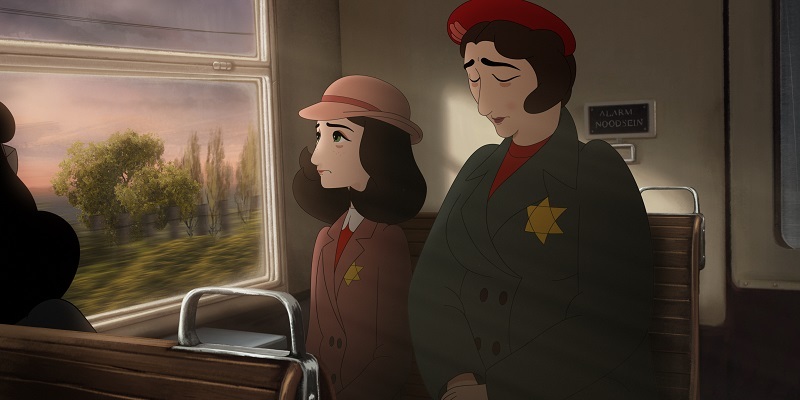
Review by
Benjamin Poole
Directed by: Ari Folman
Starring: Ruby Stokes, Emily Carey, Sebastian
Croft, Ralph Prosser, Michael Maloney, Samantha Spiro

Like everyone else who has visited Amsterdam, I went to the Anne Frank
house once. It was overwhelming but not in the way you might imagine.
Scaling the narrow staircases at Prinsengracht 263, filing through the
rooms and spaces with the rest of the tourists, passing through these
ungraceful areas where people lived their last in dignified fear, what
gets to you is how non-discriminatory the experience appeared to be for
the crowds. Hundreds upon hundreds of people lining through the Achterhuis
and past the lives of the Frank and Van Pels families (and Fritz Pfeffer)
in the same way they had the Van Gogh Museum yesterday and they would the
Science Museum later that afternoon. A rote nonchalance, of turning up at
a place because it’s there, another tick off the Amsterdam itinerary;
executed with an abiding lack of actual engagement with the surroundings.
It’s an uncomfortable observation shared by
Where is Anne Frank, Ari Folman’s magic realist animation which segues between a
realisation of the diary and the contemporary reception of Anne Frank and
her words. At the start of the film we witness early crowds queueing at
Westermarkt 20, and then, in a flawless replication of the real-life
experience, simply ambling through the rooms; maybe taking in the period
details, shuffling past the makeshift bedrooms with a nod; a right bunch
of lookie-loos (one of which, I’m certain, was meant to be actual Tom
Cruise - weird).

Our conduit through the film is Kitty (Ruby Stokes), who is a
manifestation of Anne’s (Emily Carey) imaginary friend created to
stave off loneliness. Kitty emerges from the ink and paper of the diary
late at night, a tulpa whose purpose is at first unclear. She observes the
throngs of people as a ghost and is nonplussed as to Anne’s whereabouts.
Kitty duly hooks up with Peter (Ralph Prosser), who is a street
thief and affiliated with Amsterdam’s burgeoning refugee community.
Visible only when she is away from the house, and prone to dissolving into
ink if she strays too far from the diary, Kitty’s precarious existence is
Folman’s metaphor for how Anne and the diary are perceived. In her search
for her friend, Kitty is shown the various establishments and features of
Amsterdam which bear Anne’s name, and which form the fabric of the city’s
tourist industry. In one scene she attends a dramatization of the diary at
the Theater Amsterdam (dedicated to the play) and causes a scene by
pointing out the creative liberties taken by the piece. All the while,
Kitty witnesses homeless refugees rounded up by the Politie, and later,
visits the derelict high rise where they hide. As she spends more time in
the Amsterdam of the future (the opening title card informs us that events
take place ‘A year from now...’), Kitty discovers the ultimate reality of
her maker and best friend.

Where is Anne Frank expounds the concept of Anne Frank as an
idea, not a symbol: as an (important, redemptive) figment of an
imagination made concrete, Kitty personifies this notion. Via beautiful,
flickering animation, we see a story which has been told so many times in
fresh configuration, propelled by an urgent plea to re-evaluate its
implications within a modern world. In a conceit of bravura satire,
Amsterdam is emblazoned with cheerful billboards extorting its denizens to
‘Find the Diary!’, as if the purloined journal is hidden treasure in some
mad tourist quest. The house itself is vandalised and broken into several
times during the story, too: a comment on its quotidian perception in the
city? As a freshly minted being to whom even the everyday interchanges of
life make little sense, the eventual full horror of Anne’s fate is beyond
Kitty’s understanding, as it should be for us all.

As the moving denouement of Where is Anne Frank posits, the
story has become moral comfort. We see the play, read the diary, pat each
other on the back, mutter ‘yeah, that was bad’ before moving on and
dismissing the implications of the event. We make reassuring mythology
from an ordinary misery (the amount of school assemblies I’ve witnessed
where a quote is taken from the diary, and decontextualised as part of a
glib diatribe about resilience and passing exams...an appallingly
tone-deaf appropriation). A brief scan of Where is Anne Frank’s wiki page alarmingly boasts that the film ‘was a box office bomb’ in the US (sensitive choice of words there, mate), which is a shame. Folman’s
film is for the most part joyous, and fun, and quite lovely in its drawing
of character and its sumptuous visuals (the auteur even makes concessions
towards a more commercial appeal, with would-be exciting and gravity
defying ice skate police chases about Amsterdam’s canals - the unlikely
amusement of which this reviewer didn’t take to, but which the film’s
younger target demo will probably welcome as respite).
Where is Anne Frank deserves to find an audience based on
its cinematic pleasures alone, in addition to its reinvigoration of Anne’s
story and its emotive rhetoric.

Where is Anne Frank is in UK/ROI
cinemas from August 12th.

